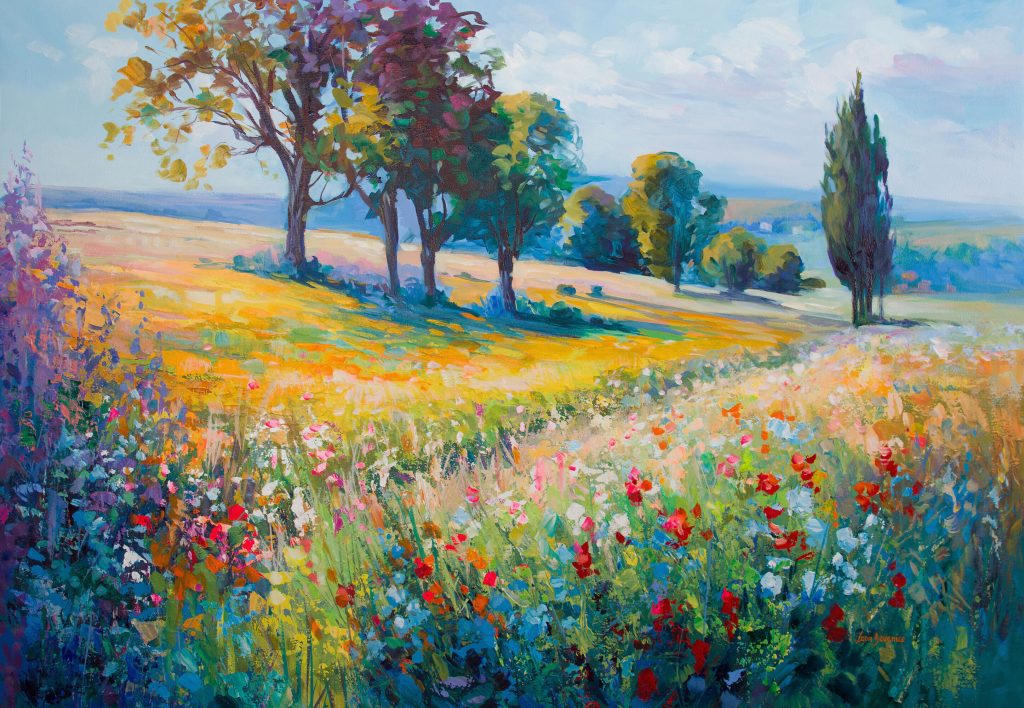Art Terminology 101: 15 Art Terms to Impress Your Friends
Having enriching and insightful conversations about art can be challenging if you don’t know the lingo. These 15 art terms will impress your friends and prepare you to discuss exhibitions confidently.
1. Abstract
A popular category on Bluethumb, abstract art moves away from the figurative (the literal way something looks), blending feelings, concepts, and spirituality with forms, colors, and composition. It shows that our brains perceive our reality, not just our eyes. Read more on abstract art here.

Bluethumb Artist Liliana Gigovic with her abstract artworks.
2. Composition
A piece’s composition is the arrangement of elements within the available space. In sculptures, this space is three-dimensional, which affects how viewers interact with the piece.
3. Conceptual
When the idea or concept behind an artwork is more important than its appearance. The emergence of modern art has helped conceptual art reach a larger audience.
4. Form
Form refers to the physical nature of the work or the element of shape within it. It is one of the seven elements of art, alongside line, shape, value, color, texture, and space. Form can be geometric (like a sphere or cube) or organic (like a leaf or human face). For centuries, form was the most important element in painting and was based, above all, on the human body.
5. Impasto

This glorious landscape, Lovers’ Lane by Kenneth Halvorsen, uses the impasto technique!
6. Impressionism
Originating in 19th-century France, Impressionism involves painting spontaneously ‘on the spot’ and often outdoors rather than in a studio from preliminary sketches. The main impressionist subjects were landscapes and scenes of everyday life. Today, Impressionism is primarily characterized by a painting’s small yet visible brush strokes, its emphasis on accurately depicting light in its changing qualities, and, similarly, the feeling of movement – as if we are experiencing the piece in a fleeting time.

Impressionist landscape painting Wildflower Meadow In Bloom by Leon Devenice.
7. Medium
Medium is a term that can be used in both broad and specific contexts. It refers to a type of art (painting, printmaking, sculpture) or the material used (oil on canvas, gouache on paper).
Fun fact: the plural of the medium is media. Each artwork on Bluethumb lists its medium so you can refine your search for the perfect artwork!

Bluethumb Co-founder George Hartley sports a fun lino print above his mantelpiece.
8. Memento Mori
A memento mori is an artwork designed to remind viewers of their mortality and life’s fragility. It uses symbols like skulls, hourglasses, and bubbles to convey the transience of life.

Memento Mori Valhalla by Tom Hermann features the accouterments of the Mighty Thor. It explores death and the celebration and legacy of life.
9. Modern
In the early 20th century, artists began using new imagery, techniques, and materials to reflect modern society’s reality and values, marking the start of modern art.

Modern abstract artwork Sunburnt Oxide by Franko.
10. Narrative
Narrative art is art that tells a story. Until the twentieth century, Western art predominantly depicted religious, mythological, or historical tales. At this time, it was assumed the audience was familiar with the story on which the artwork was based. In modern art, narratives may be more coded and require knowledge about the artist to understand the artwork entirely.
11. Still Life
A still life is a work of art depicting mostly inanimate subject matter, typically commonplace objects that are natural or manufactured. These items are usually set on a table and include fruit, flowers, glassware, and textiles, giving everyday objects new value.

Lunch At Nonna’s Table by Veneranda Russo Cornelio
12. Surrealism
Surrealism is a movement that rejects logic and embraces the unconscious and dreams. Famous surrealists like Dalí brought magic and strangeness to their work and continue to inspire contemporary artists.

Yulia Pustoshkina is a Surrealism veteran on Bluethumb.
13. Symbolism
Still life is a late 19th-century movement that focused on expressing ideas through realistic and figurative art rather than literal description. It often incorporates symbolism to convey deeper meanings.
The painting below is a perfect example. Melissa Ritchie captures a day in the life of a busy working woman by using a handbag, which is this piece’s metaphor for the day, with its contents strewn about and each object having its analogy. For example, the list shows family commitments, the glasses represent vision, the headphones show focus, and the Ventolin depicts breath.

Arsenal for Today (Grey) by Melissa Ritchie
14. Tone
Tone refers to the lightness or darkness of a color in a painting. A single color can have an infinite number of tones. Use this art term to impress your friends when discussing color.

Solana by Katie Wyatt captures the myriad shades of blue in nature’s seascape.
15. Verism
Last on our list is the most uncommon term! Stemming from Latin, verism describes strict naturalism in art, portraying everyday subjects with imperfections. This “warts and all” approach to representation dates back to the Roman Republic era.
Impress your friends on your next visit to the local gallery! By learning these art terms, you can talk confidently about art.








